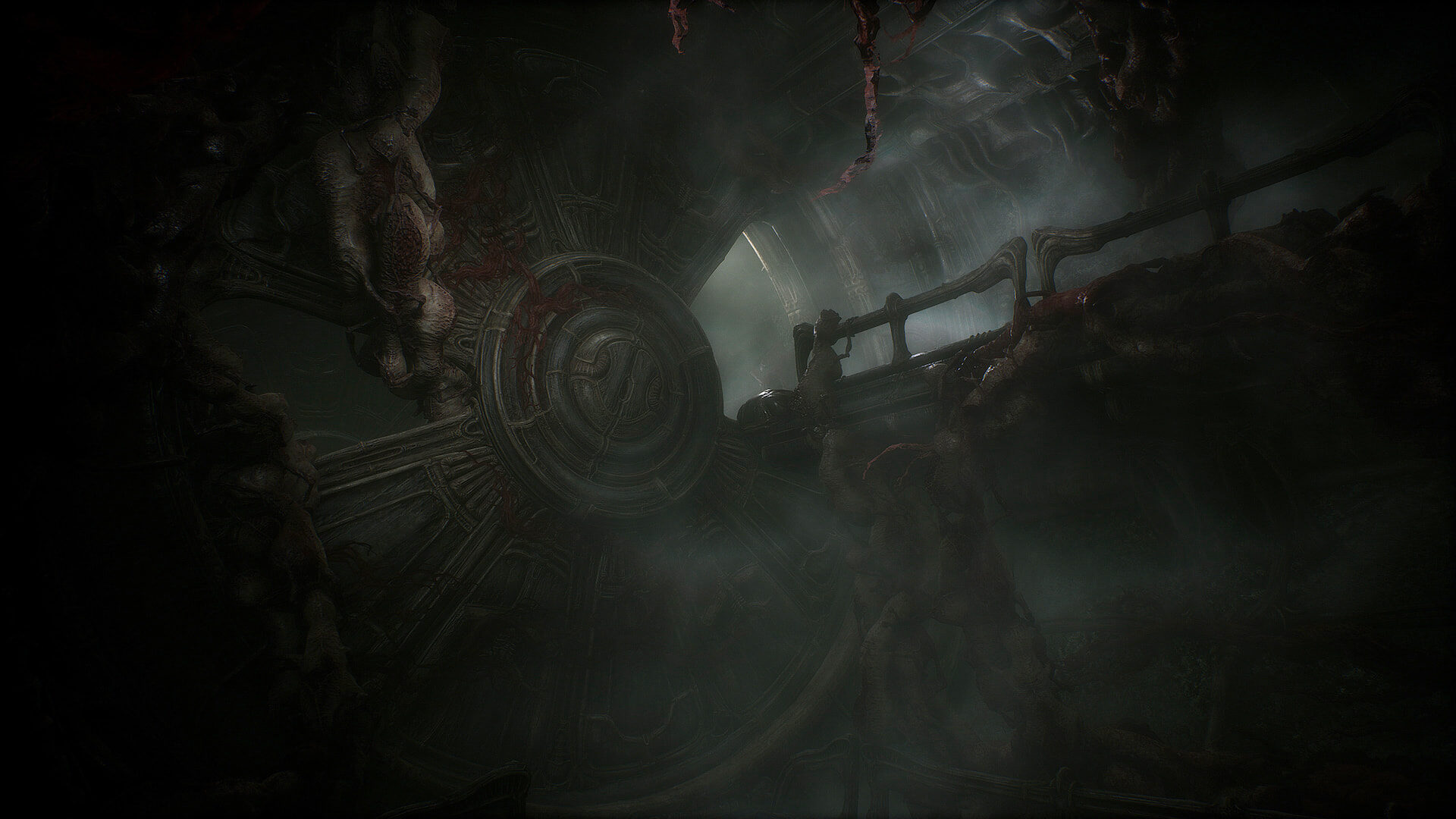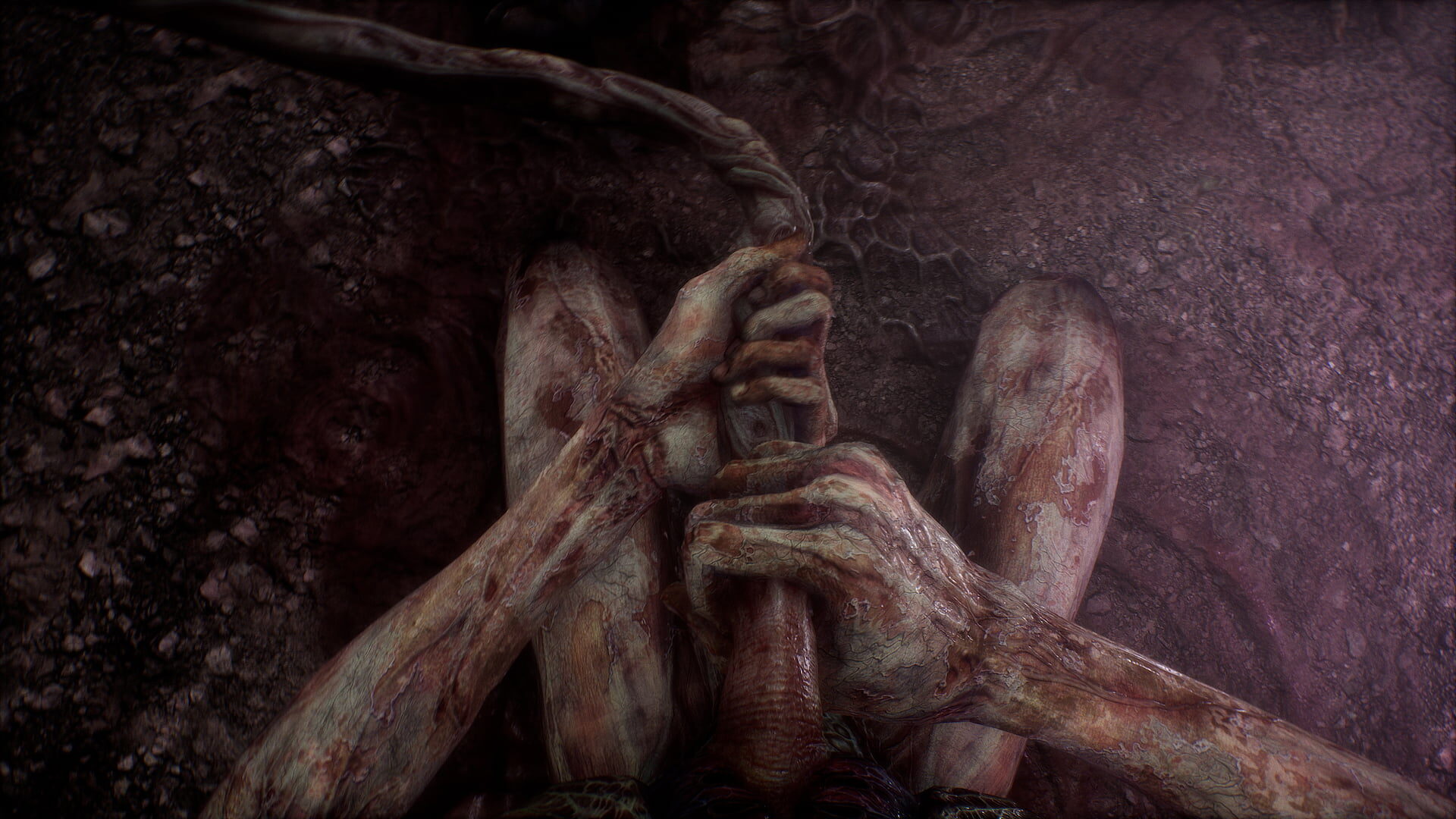The biggest draw of Scorn, Ebb Software’s long-awaited horror adventure game, is its distinctive art style. Not only did the team make no effort to hide that its influences are H.R. Giger and Zdzislaw Beksiński, but it proudly made its inspirations known. The works of Giger can be seen in the mix of the organic and inorganic, the scientific and the sexual, whereas Beksiński provides Scorn’s color palette and more nightmarish visions, especially when it comes to the enemy designs.
While these influences are obvious, the way that Ebb combines them is utterly unique, at least when it comes to video games. Truly, I’ve never experienced a virtual world quite like Scorn’s abandoned hellscape. Roaming its hallways feels like traveling inside the intestines of a cyborg’s corpse, feeling more like hell than what you’ll find in any Doom. Here, flesh is manufacturable, the biological and the mechanical indistinguishable. It’s goopy and gross and eerie, with body horrors waiting around every corner, but it’s also exhilarating and captivating in a way that most games—even the most graphically impressive—rarely are. Maybe it’s because Scorn’s main artistic influences are noted surrealist painters and not the kinds of sci-fi or horror movies that usually influence games, that this one feels so magical.

Scorn’s set design might border on the maximalist to a grotesque degree, but it’s also restrained when it needs to be. Specifically, its minimal UI design keeps you in the experience by not throwing a bunch of numbers and figures and waypoints your way. Sure, there are moments where video game tropes clash with Ebb’s dedication to creating immersion in frankly hilarious ways. What kind of game would Scorn be if it didn’t make you pull a bunch of levers or ride elevators? Only, this time, the lever looks like protruding flesh, and in order to operate it you have to stick your fingers into tiny orifices and pull. The sound design and musical cues from Aethek and Lustmord take a similarly minimalist approach, amping up the drama without ever becoming distracting, as if the music were itself a part of the world.
The brilliant art design does a lot of the heavy lifting when it comes to selling Scorn’s narrative. The game purposefully drops you into the world without any sort of cutscene or explanation, literally starting from the main menu where your character wakes up. The only motivation you get is to figure out how to get to the next area, and that’s based solely on your own propensity as a player, not something Scorn tells you to do.
Ebb’s approach to storytelling is even more opaque than FromSoftware’s, but it’s still possible to come to a few conclusions. The level design, from both a practical and artistic perspective, sells the idea that everything in this world is connected. Behind the fleshy grotesqueries of Scorn’s world, there’s a real sense of an abandoned, previously self-sustaining ecosystem, needing you only as a catalyst to get it going again.
The puzzles themselves also often seem like they stem from some kind of internal logic, even if that logic is incomprehensible at first. You might even feel like they make no sense at all. Why do you need to cart around some humanoid creature so that a machine can rip his arm off? Couldn’t you just, you know, rip his arm off yourself? Or why do I need to place a tiny man in a jar into the belly of a mechanical body, when in the end all I actually need to do is break the jar and squeeze the organ juices from the tiny man’s corpse?

I still don’t know the answers to these questions, but part of me is fine with not knowing. On the one hand, I like that Scorn lets me come (pun intended?) to my own conclusions. In my mind, it’s a game about the cycle of birth and death, the painful and unavoidable reality of having a body, a vehicle made out of flesh, and how that can feel like a prison or a death sentence. Clearly, it’s meant to disturb, horrify, bewilder, and even make you laugh at times.
What kept me going in Scorn was seeing what kind of terror and beauty awaited around every corner, and the promise that I might find some kind of solace or answers. What didn’t keep me going was the actual gameplay. While it’s mostly a puzzle-heavy adventure game, Scorn also dabbles with first-person action. Yes, there’s a gun—a weird, fleshy gun—but it’s less a weapon and more a tool, an element that provides a relief from tension. While I appreciate the idea that a horror game should have horrific enemies, and that players should be able to fight back against those enemies, Scorn’s combat feels more annoying than tense. The enemies themselves are cool and disturbing, but there are only four different variants. Likewise, the gun itself is fun to use, but it only has four different modes, the last of which you unlock near the very end and almost solely for puzzle-solving purposes. On top of all that, you don’t really have any way to defend against enemies other than sprinting in circles around them and hoping their attacks don’t hit you, which is a crapshoot.
Mostly, though, you’ll be solving puzzles, and that’s where Scorn is a little more successful. Scorn’s world is divided into smaller areas that themselves are big puzzles, containing even smaller areas with smaller puzzles. You have to solve the small puzzles so that you can solve the big puzzles. When this formula works, and you escape an area after clearing all its puzzles and figuring out how they connect, it’s really satisfying. But those smaller puzzles can be hit-or-miss, with some feeling a little too tedious, generic and video game-y.
That said, while the gameplay itself isn’t exactly the most fun, like everything else in Scorn’s world, it serves a larger purpose. In this case, that’s giving players a sense of discovery, of feeling lost in an abandoned world. Taking an even wider view, everything in Scorn seems built around the simple desire of making players feel like they’re somewhere new, somewhere unexplored and maybe even hostile to the idea of being understood. Playing through Scorn is like having a nightmare, and not because it’s buggy or unfinished like some games. Nightmares can be intoxicating precisely because they are so different from our normal lives, because they trigger that innate excitement of facing the unknown. That’s what Scorn captures—the feeling of being horrified and disturbed, exhilarated and intrigued—even after you’ve woken up.

Images: Kepler Interactive
|
★★★★☆
Scorn is a daring aesthetic experiment in virtual, interactive science fiction. Taking inspiration from the art of H.R. Giger and Zdzislaw Beksiński, developer Ebb Software seems hellbent on giving its players a surreal, nightmarish experience, and it mostly succeeds. While combat can feel like a secondary concern, Scorn’s puzzles provide just enough challenge to keep the game from feeling like a “walking simulator.” Really, though, the main attraction is Scorn’s compelling world, a fully realized artistic vision that will haunt you for days after experiencing it. |
Developer Ebb Software Publisher Kepler Interactive ESRB M - Mature Release Date 09.14.2022 |
| Scorn is available on Xbox Series X/S and PC. Primary version played was for PC. Product was provided by Kepler Interactive for the benefit of this coverage. EGM reviews on a scale of one to five stars. | |

Michael Goroff has written and edited for EGM since 2017. You can follow him on Twitter @gogogoroff.